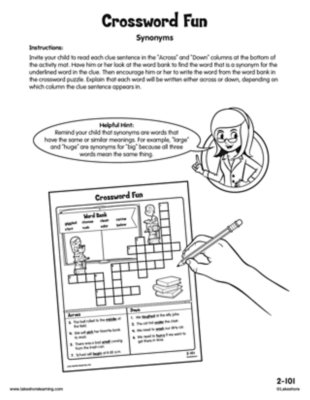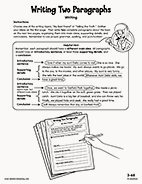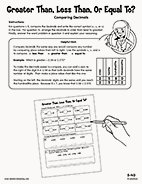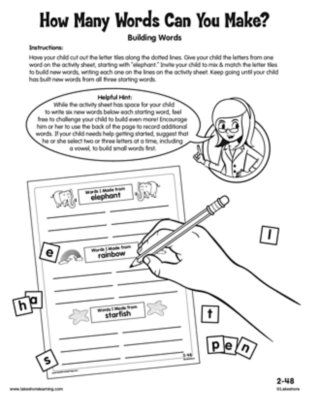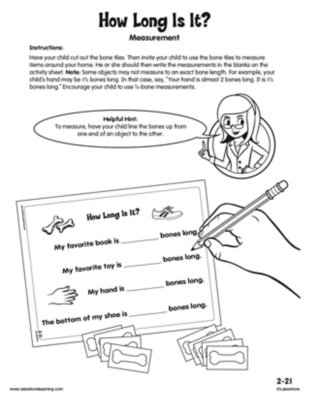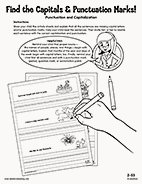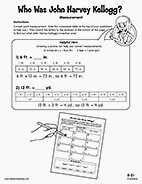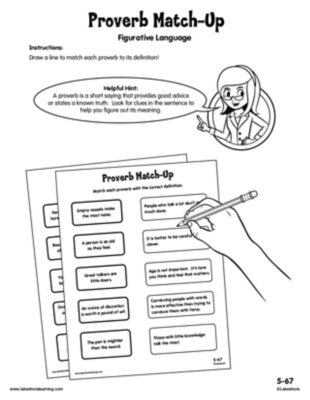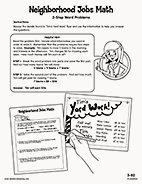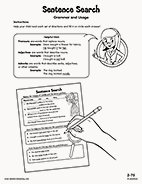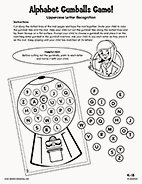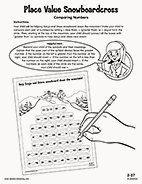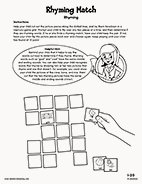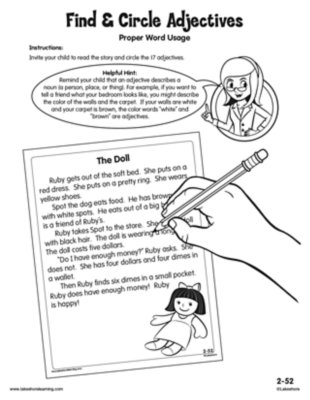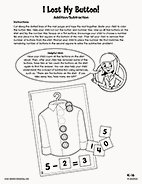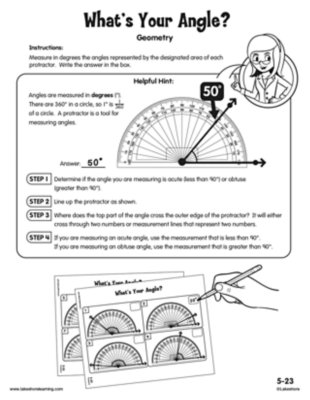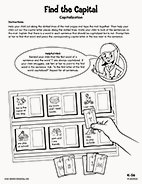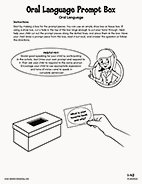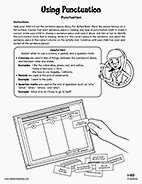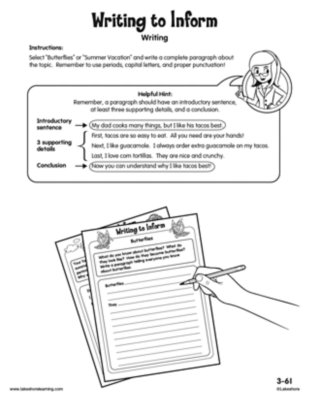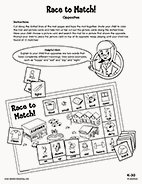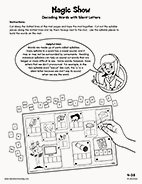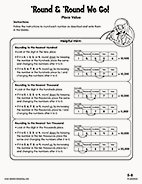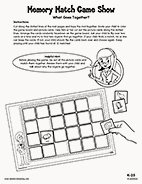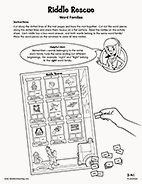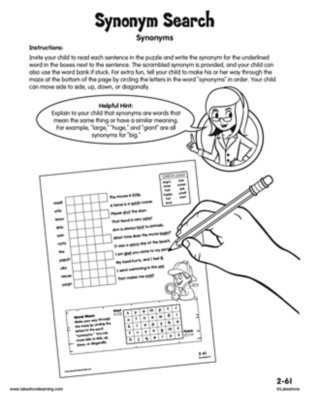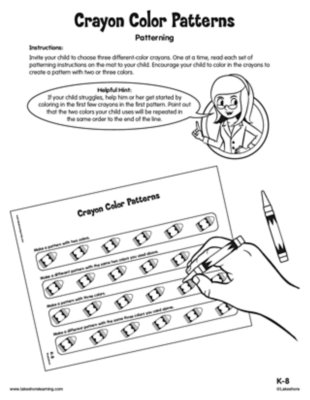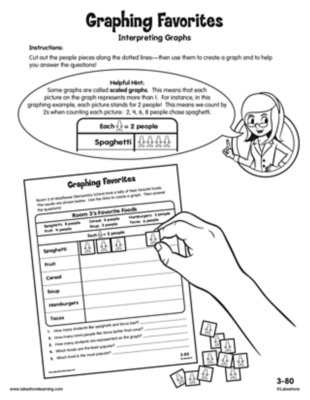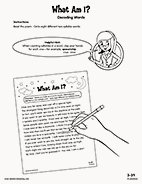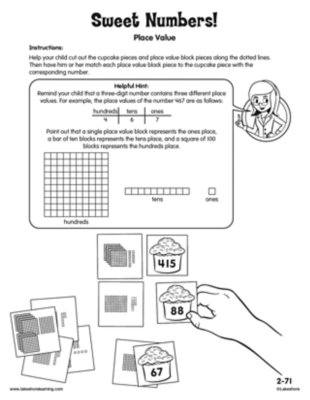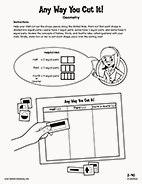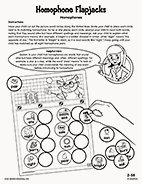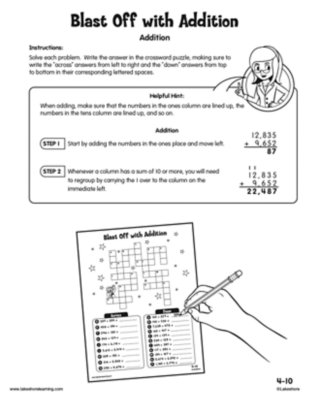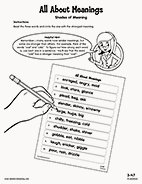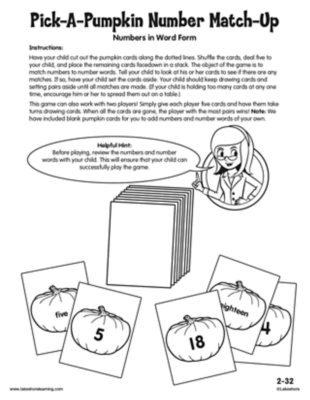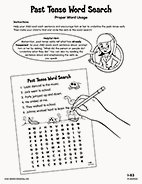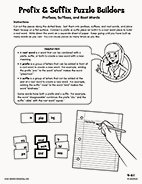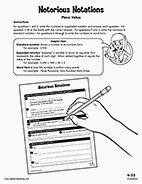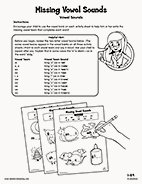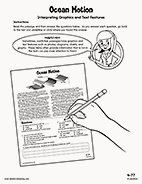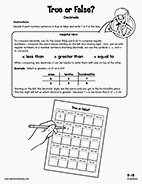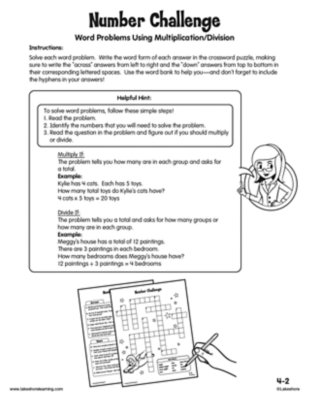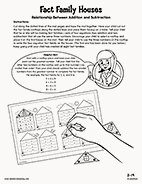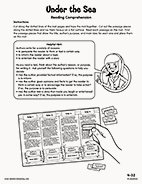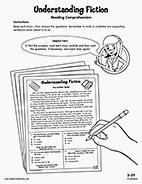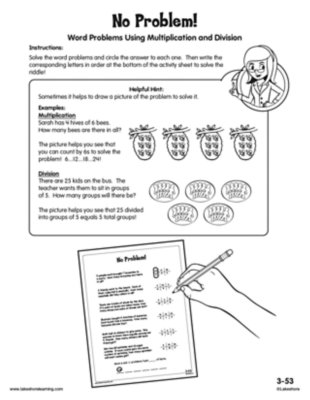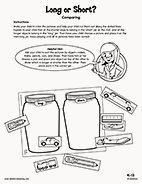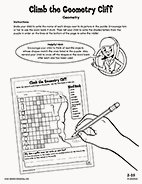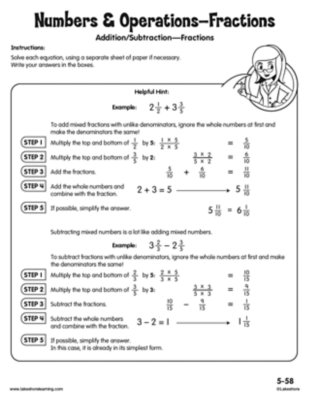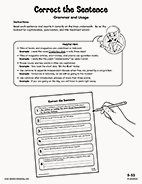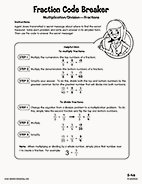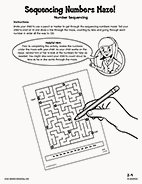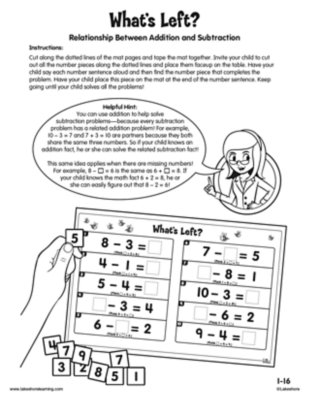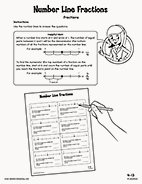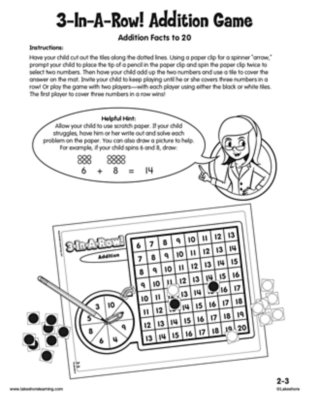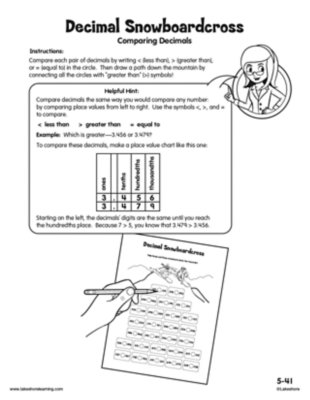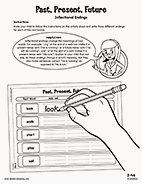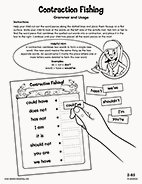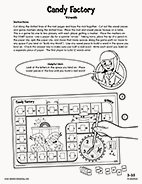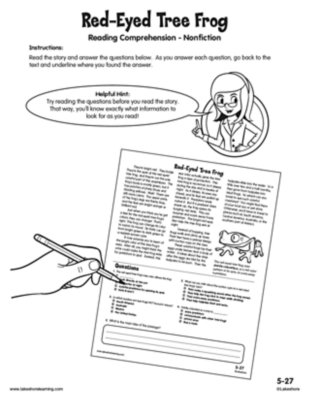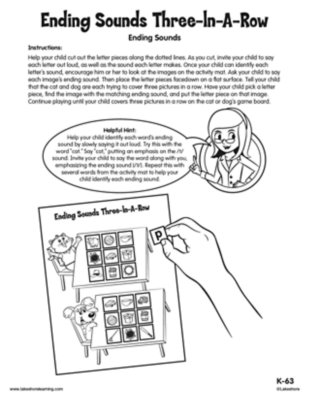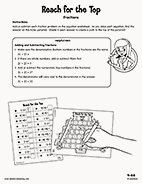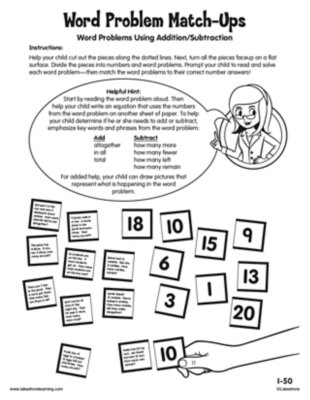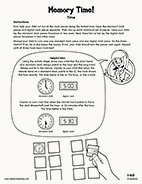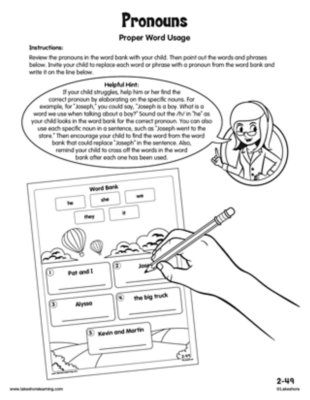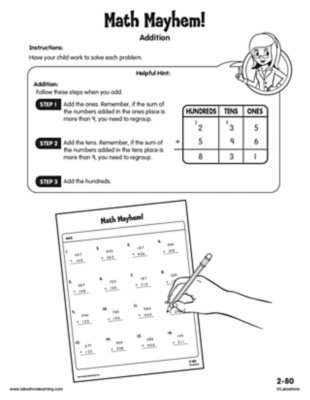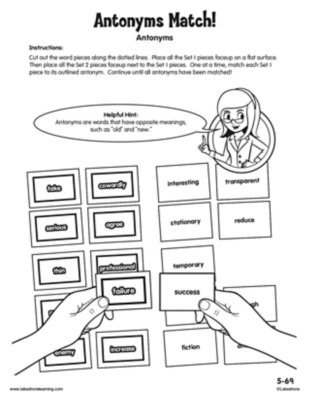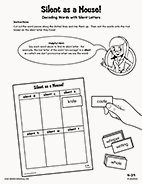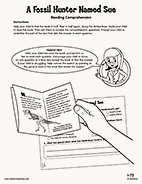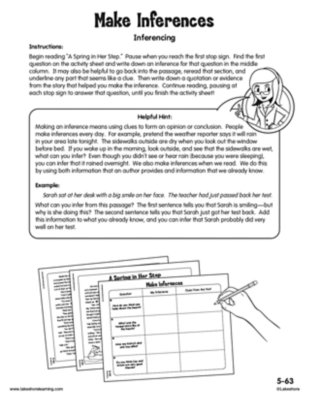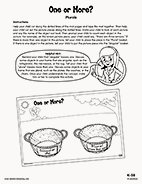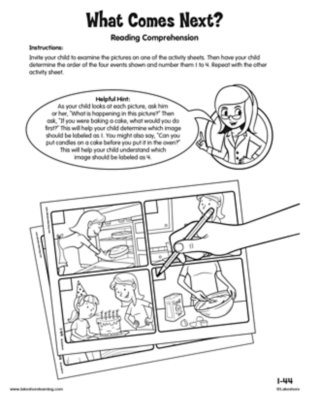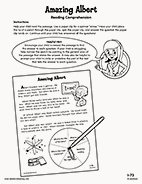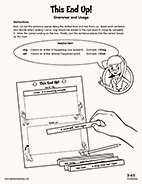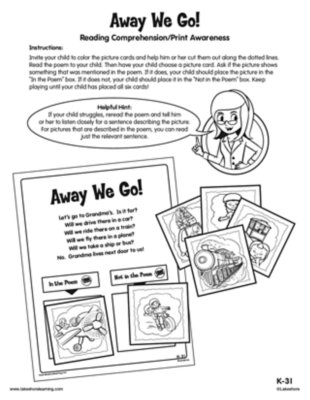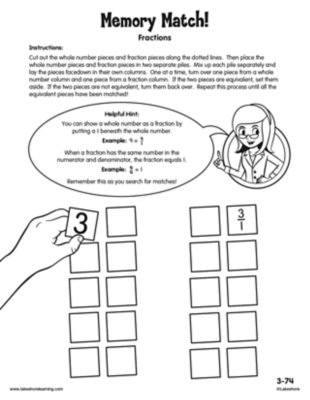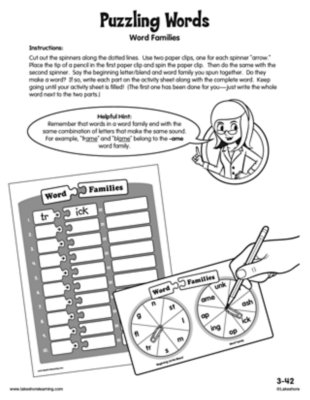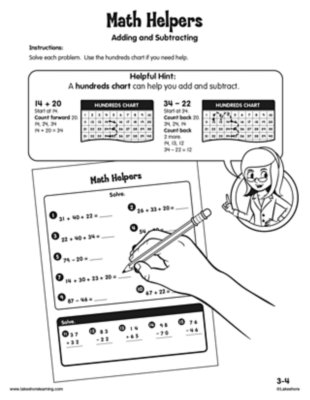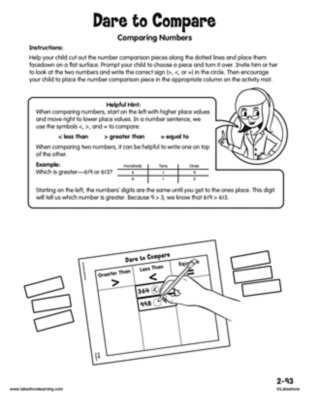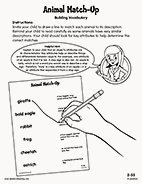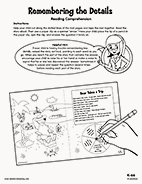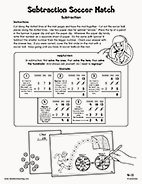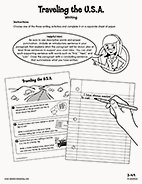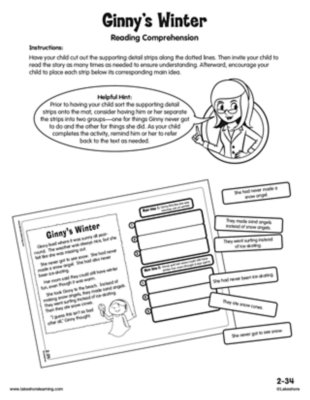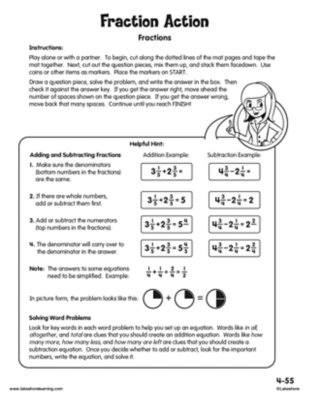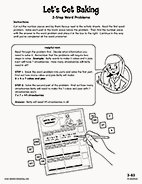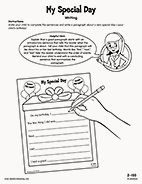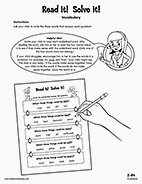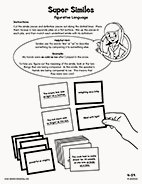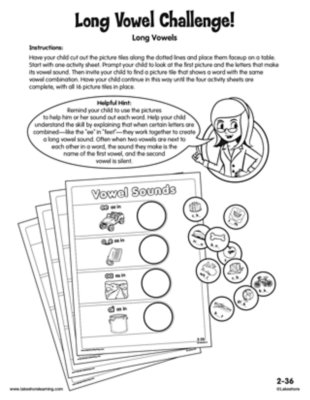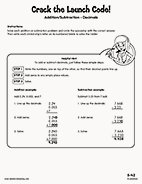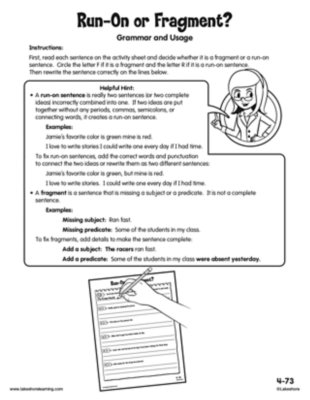
During fourth grade, your child will learn many new rules of English grammar and usage, including rules about sentence fragments and run-on sentences, relative pronouns (which, that), relative adverbs (where, when, why), the correct order of adjectives and more.
View worksheetDuring second grade, your child will learn to identify synonyms of words and use the synonyms in sentences.
View worksheetDuring third grade, your child will learn to write opinion pieces that are supported with reasons, informative texts that convey ideas and information clearly, and narratives (stories) that include descriptive details and a clear sequence of events.
View worksheetDuring fifth grade, your child will learn to compare decimals to the thousandths place using the greater than (>), less than (<) and equal to (=) symbols, such as 0.392 > 0.329.
View worksheetWhen entering second grade, your child should be able to build and spell simple words by blending sounds together. For example, when given the letters “a,” “e,” “c,” “b,” “d,” “g” and “s,” your child should be able to use the letters to build and read at least three words.
View worksheetWhen entering second grade, your child should be able to measure an object’s length by lining up multiple units of a shorter object end to end and naming how many units long the object is. For example, using paper clips to measure the length of a table.
View worksheetWhen entering second grade, your child should remember to capitalize dates and people’s names. Your child will also be expected to use punctuation at the ends of sentences. Your child should also use commas in dates and to separate words in a series. For example, “I like apples, bananas, and strawberries.”
View worksheetWhen entering fifth grade, your child should be able to solve problems involving measurement and conversion of measurement.
View worksheetDuring fifth grade, your child will learn to interpret examples of figurative language, including similes and metaphors, based on the context in which they are used. Your child will also learn to recognize and explain the meaning of common idioms and familiar sayings and expressions, such as, “A bird in the hand is worth two in the bush.”
View worksheetDuring third grade, your child will learn to solve two-step word problems involving addition, subtraction, multiplication and division.
View worksheetDuring second grade, your child will learn many rules of English grammar and usage, including how to use adjectives and adverbs correctly, how to form and use contractions, and how to rearrange sentences to read correctly.
View worksheetWhen entering kindergarten, your child should be able to recognize and name some uppercase letters, especially those in your child’s name.
View worksheetWhen entering second grade, your child should be able to determine if a two-digit number is greater than, less than or equal to another two-digit number and use the >, < and = symbols to show the answer.
View worksheetWhen entering first grade, your child should be able to recognize and create rhyming sounds.
View worksheetWhen entering second grade, your child should be able to correctly use pronouns, singular and plural words, and past-, present- and future-tense words in sentences.
View worksheetWhen entering kindergarten, your child should be able to perform simple addition and subtraction using objects or their fingers. For example, “If we have 3 apples and add 2 more, how many apples do we have altogether?”
View worksheetWhen entering fifth grade, your child should be able to identify lines and angles, measure angles, understand symmetry and classify shapes based on their lines and angles. For example, your child should be able to classify right triangles by seeing that they have a 90-degree angle.
View worksheetDuring kindergarten, your child will learn that sentences begin with a capital letter and that the word “I” is also capitalized.
View worksheetWhen entering first grade, your child should be able to describe familiar people, places, things and events and express their thoughts, feelings and ideas clearly.
View worksheetDuring first grade, your child will learn to capitalize dates and people’s names. Your child will also learn how to use punctuation at the ends of sentences, as well as how to use commas in dates and to separate words in a series. For example, “I like apples, bananas, and strawberries.”
View worksheetDuring third grade, your child will learn to write opinion pieces that are supported with reasons, informative texts that convey ideas and information clearly, and narratives (stories) that include descriptive details and a clear sequence of events.
View worksheetWhen entering kindergarten, your child should be able to understand the most common opposites, such as “happy/sad” and “stop/go.”
View worksheetWhen entering fourth grade, your child should be able to decode and spell multisyllable words and grade-appropriate irregularly spelled words.
View worksheetWhen entering fifth grade, your child should be able to compare and round multidigit numbers. Your child should also be able to read and write multidigit numbers in number, word and expanded form. For example, 765; seven hundred sixty-five; 700 + 60 + 5.
View worksheetWhen entering kindergarten, your child should be able to group common objects into categories and identify reasons for grouping the objects. For example, if given a lamp, sofa and zebra, your child should be able to group the lamp and sofa together because they are household items, while the zebra is not.
View worksheetWhen entering third grade, your child will be expected to know many rules of English grammar and usage, including how to correctly use adjectives, adverbs, pronouns, past-tense verbs and plural words.
View worksheetWhen entering third grade, your child should be able to use common spelling patterns to decode and spell words easily, such as “cart,” “chart” and “smart.”
View worksheetWhen entering second grade, your child should be able to identify words with similar meanings and distinguish subtle differences between them. For example, “large” and “gigantic” are synonyms, but “gigantic” has a stronger meaning than “large.”
View worksheetWhen entering kindergarten, your child should be able to copy simple patterns, such as ABAB, and determine what comes next in the pattern.
View worksheetDuring third grade, your child will learn to use bar graphs to solve one- and two-step problems asking “how many more” and “how many less.”
View worksheetWhen entering third grade, your child should be able to decode—or read and understand—two-syllable words by applying word analysis skills and by sounding out words.
View worksheetDuring second grade, your child will learn to identify groups of hundreds, tens and ones when counting. Your child will also learn that the three digits in a three-digit number represent hundreds, tens and ones. For example, there are 7 hundreds, 2 tens and 6 ones in the number 726.
View worksheetDuring second grade, your child will learn to recognize shapes and identify their attributes, such as how many sides, angles or vertices (corners) they have. Your child will also learn to divide circles and rectangles into halves, thirds and fourths.
View worksheetWhen entering second grade, your child should be able to figure out the correct meanings of grade-appropriate homophones—words that sound the same but have different meaningss. For example, “to” and “two” or “eye” and “I.”
View worksheetWhen entering fourth grade, your child should be able to easily add and subtract within 1,000.
View worksheetWhen entering third grade, your child should be able to distinguish shades of meaning among closely related words—such as “toss,” “throw” and “hurl”—and identify which word has the strongest meaning.
View worksheetWhen entering second grade, your child should be able to read a number up to one hundred and write its corresponding numeral. For example, forty-one = 41.
View worksheetWhen entering third grade, your child should be able to analyze fiction and nonfiction texts—identifying elements such as main ideas, key details and the author’s purpose.
View worksheetDuring first grade, your child will learn subtleties in words’ meanings and make real-life connections between words and their use, such as understanding that both a bed and sofa could be called cozy.
View worksheetDuring fourth grade, your child will learn to use common, grade-appropriate Greek and Latin prefixes, suffixes and roots to figure out the meaning of a word. For example, “telegraph,” “photograph” and “autograph” all contain the Greek root “graph,” which refers to something that is written or drawn.
View worksheetDuring fourth grade, your child will learn to identify the value of each digit in a multidigit number. Your child will also learn to read and write multidigit numbers in number, word and expanded form. For example, 765; seven hundred sixty-five; 700 + 60 + 5.
View worksheetDuring first grade, your child will learn to distinguish between short and long vowels in spoken one-syllable words, such as the short “a” in “cap” and the long “a” in “cape.” Your child will also learn that final -e and common vowel teams can be used to make long vowel sounds, such as the long “o” in “rope” and “coat.”
View worksheetDuring fourth grade, your child will learn to interpret information from charts, graphs, diagrams, time lines, animations and interactive Web pages, and explain how that information helps them understand a text.
View worksheetWhen entering fifth grade, your child should be able to compare decimals to the hundredths place, such as 0.45 and 0.07. Your child should also be able to write fractions with denominators of 10 or 100 as decimals, such as writing 3/10 as 0.3 and writing 34/100 as 0.34.
View worksheetWhen entering fourth grade, your child should know how to solve word problems involving multiplication and division within 100.
View worksheetWhen entering second grade, your child should understand that addition and subtraction are related. Your child should also be able to determine the missing number in an addition or subtraction equation. For example, 6 + __ = 8.
View worksheetWhen entering fourth grade, your child should be able to read and analyze level-appropriate stories, dramas, poems and informational texts, identifying elements such as main ideas, key details and the author’s purpose.
View worksheetDuring third grade, your child will learn to read and analyze level-appropriate stories, dramas, poems and informational texts, identifying elements such as key events and details, the main idea and the theme or moral.
View worksheetDuring third grade, your child will learn to solve word problems involving multiplication and division within 100.
View worksheetWhen entering kindergarten, your child should be able to compare objects and describe their similarities and differences, including distinguishing by color, size, weight or shape. Your child should also be able to describe objects using the correct words, such as “big,” “small,” “short” and “tall.”
View worksheetWhen entering second grade, your child should understand the attributes of different shapes—such as a triangle’s three sides—and be able to draw a variety of 2-D shapes.
View worksheetDuring fifth grade, your child will learn to add and subtract fractions with different denominators. For example, 1/3 + 1/4 = 4/12 + 3/12 = 7/12.
View worksheetDuring fifth grade, your child will learn many new rules of English grammar and usage, including how to correctly use verb tenses, conjunctions and prepositions in sentences. Your child will also learn new rules about the correct use of punctuation and capitalization when forming sentences and paragraphs.
View worksheetDuring fifth grade, your child will learn to multiply fractions by whole numbers and by other fractions (2/3 x 4 = 8/3 or 2/3 x 4/5 = 8/15). Your child will also learn to divide fractions by whole numbers and whole numbers by fractions (1/3 ÷ 4 = 1/12 or 4 ÷ 1/2 = 8).
View worksheetWhen entering second grade, your child should be able to count, read and write numbers up to 120, beginning with any number. For example, 116, 117, 118, 119, 120.
View worksheetWhen entering first grade, your child should be able to use objects or drawings to answer “How many more make 10?” when given a number. Your child should also be able to use objects or drawings to break apart any number up to 10 in more than one way, such as breaking up the number 7 into 5 and 2, as well as 3 and 4.
View worksheetWhen entering fourth grade, your child should understand fractions as numbers and be able to represent fractions on a number line, compare fractions and identify equivalent fractions.
View worksheetWhen entering second grade, your child should be able to add to 20 fluently. For example, 5 + 9 = 14 and 13 + 7 = 20.
View worksheetDuring fifth grade, your child will learn to compare decimals to the thousandths place using the greater than (>), less than (<) and equal to (=) symbols, such as 0.392 > 0.329.
View worksheetWhen entering second grade, your child should be able to read words with inflectional endings and use them correctly in sentences. Inflectional endings are letters that are added to words, such as “-ing,” “-es,” or “-ed.” For example, your child should be able to read the words “wishing,” “wishes” and “wished” and use them correctly in sentences.
View worksheetDuring second grade, your child will learn many rules of English grammar and usage, including how to use adjectives and adverbs correctly, how to form and use contractions, and how to rearrange sentences to read correctly.
View worksheetWhen entering third grade, your child should be able to distinguish long and short vowels when reading regularly spelled one-syllable words, such as “mad” and “made,” and know how to spell words using common vowel teams, such as “ai,” “ea,” “ee,” “oa” and “oi.”
View worksheetWhen entering fifth grade, your child should be able to read, analyze and understand level-appropriate nonfiction reading passages, finding the main idea and important details, comprehending key words and phrases, comparing different accounts of the same event or topic and making inferences.
View worksheetDuring kindergarten, your child will learn to identify the ending sounds in simple words and identify the letter that makes them, such as identifying the “n” sound in “pen.”
View worksheetDuring fourth grade, your child will learn to add and subtract fractions and mixed numbers with the same denominator. For example, 1 1/5 + 3 2/5 = 4 3/5.
View worksheetDuring first grade, your child will be asked to solve word problems that involve adding and subtracting within 20.
View worksheetDuring first grade, your child will learn to tell and write time in hours and half-hours using clock faces and digital clocks.
View worksheetDuring third grade, your child will learn to capitalize the appropriate words in titles, such as the names of books and movies. Your child will also be expected to use commas in written addresses and with quotation marks to show when someone is speaking.
View worksheetWhen entering second grade, your child should be able to correctly use pronouns, singular and plural words, and past-, present- and future-tense words in sentences.
View worksheetDuring second grade, your child will learn to add and subtract within 1,000, using regrouping when needed. For example, 937 — 469 = 468.
View worksheetWhen entering second grade, your child should be able to measure an object’s length by lining up multiple units of a shorter object end to end and naming how many units long the object is. For example, using paper clips to measure the length of a table.
View worksheetDuring fifth grade, your child will learn to use the relationship between synonyms (words with similar meanings) and antonyms (opposites) to better understand each of the words.
View worksheetWhen entering fourth grade, your child should be able to decode and spell multisyllable words and grade-appropriate irregularly spelled words.
View worksheetDuring first grade, your child will answer questions about key details in stories, such as identifying characters, settings and events, identifying who is telling the story and retelling the story in their own words. Your child will also learn to tell the difference between books that tell stories and books that provide information.
View worksheetDuring fifth grade, your child will learn to make inferences when reading fiction and nonfiction text passages, citing places in the text that led your child to draw certain conclusions.
View worksheetDuring kindergarten, your child will learn to form regular plural nouns when speaking by adding -s or -es. For example, “dog/dogs” and “wish/wishes.”
View worksheetWhen entering first grade, your child should be able to listen to a story and answer questions about key details, such as identifying characters and events and retelling the story in their own words. Your child should also be able to identify parts of a book—such as the front cover, back cover and title page—as well as the role of authors and illustrators.
View worksheetDuring first grade, your child will answer questions about key details in stories, such as identifying characters, settings and events, identifying who is telling the story and retelling the story in their own words. Your child will also learn to tell the difference between books that tell stories and books that provide information.
View worksheetDuring third grade, your child will learn many new rules of English grammar and usage, including rules about parts of speech, regular and irregular plural nouns, regular and irregular verbs, verb tenses, subject-verb agreement, sentence structure and more.
View worksheetWhen entering kindergarten, your child should be able to listen to a story and ask and answer questions about key details, such as identifying characters and events and retelling the story in their own words. Your child should also understand the basic features of print, such as differentiating letters from words, recognizing that words have spaces between them and distinguishing the roles of authors and illustrators.
View worksheetDuring third grade, your child will learn to compare fractions and represent whole numbers as fractions. For example, 4/4 = 1 whole and 3/1 = 3 wholes.
View worksheetWhen entering third grade, your child should be able to use common spelling patterns to decode and spell words easily, such as “cart,” “chart” and “smart.”
View worksheetWhen entering third grade, your child should be able to add and subtract two 3-digit numbers (327 + 216 or 452 — 318), add multiple 2-digit numbers (22 + 14 + 36 + 61) and find the missing number in equations (14 + __ = 19).
View worksheetDuring second grade, your child will learn to determine if a three-digit number is greater than, less than or equal to another three-digit number and use the >, < and = symbols to show the answer.
View worksheetWhen entering second grade, your child should be able to define words by category and key attributes. For example, “A duck is a bird that swims.”
View worksheetDuring kindergarten, your child will be asked to listen to a story and answer questions about key details, including identifying characters and events and retelling the story in sequence.
View worksheetWhen entering fourth grade, your child should be able to easily add and subtract within 1,000.
View worksheetWhen entering third grade, your child should be able to write a paragraph with an opening, three or more details and a closing.
View worksheetWhen entering second grade, your child should be able to recall and identify key events, facts and details in grade-appropriate fiction and nonfiction texts.
View worksheetDuring fourth grade, your child will learn to add and subtract fractions and mixed numbers with the same denominator. For example, 1 1/5 + 3 2/5 = 4 3/5.
View worksheetDuring third grade, your child will learn to solve two-step word problems involving addition, subtraction, multiplication and division.
View worksheetWhen entering second grade, your child should be able to write short opinion pieces, informative texts and narratives (stories).
View worksheetDuring second grade, your child will build vocabulary and learn to distinguish shades of meaning among closely related words, such as “toss,” “throw” and “hurl” or “thin,” “slender” and “skinny.”
View worksheetDuring fourth grade, your child will learn to understand the meaning of figurative language, including similes, metaphors and idioms.
View worksheetWhen entering second grade, your child should understand that final -e and common vowel teams can be used to make long vowel sounds. For example, your child can recognize that the “oa” and “o_e” teams in the words “coat” and “rope” contain long “o” sounds. Your child should also be able to spell words using these vowel teams.
View worksheetDuring fifth grade, your child will learn to add and subtract decimals to the hundredths place. For example, 2.32 + 3.41 = 5.73.
View worksheet
